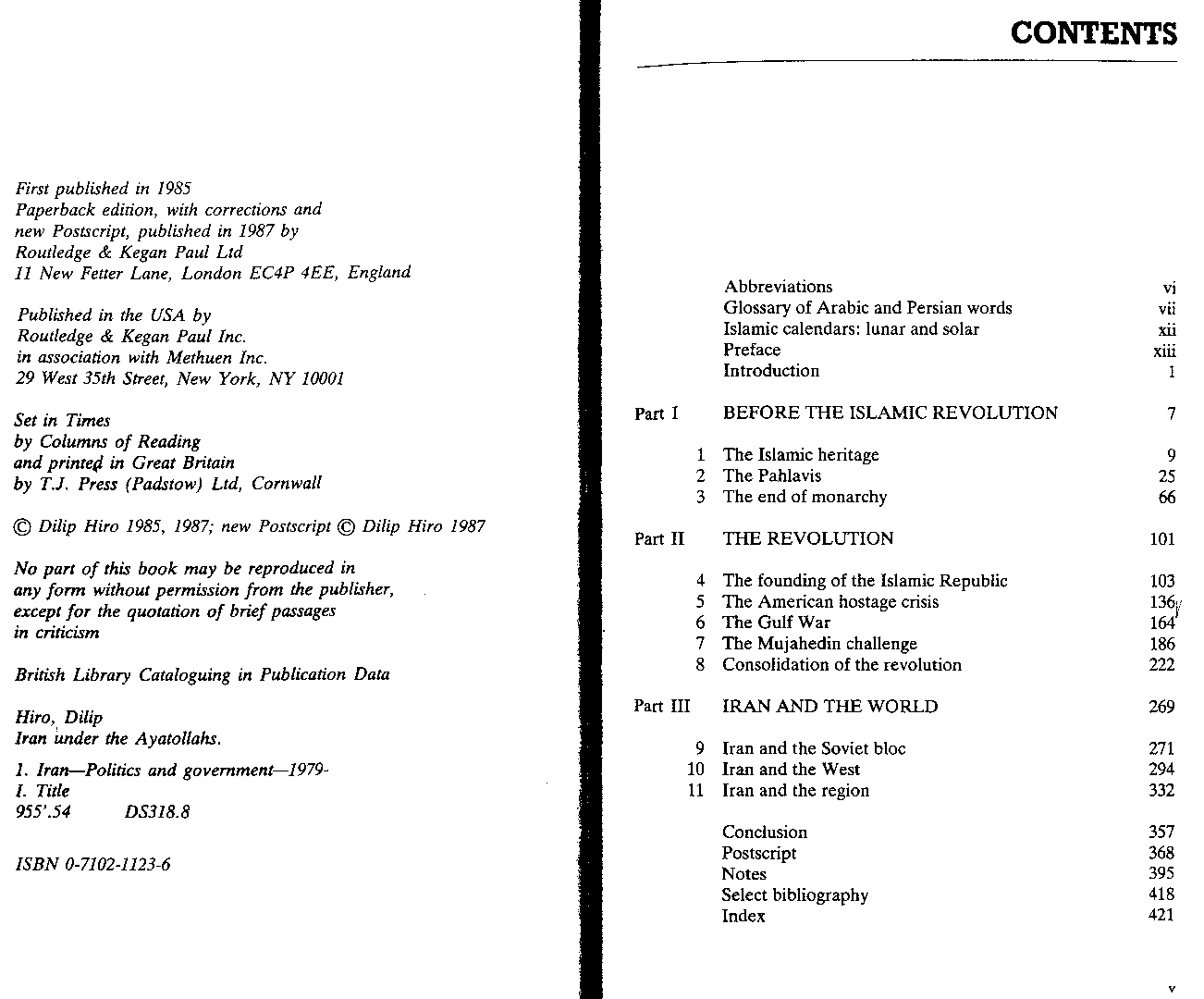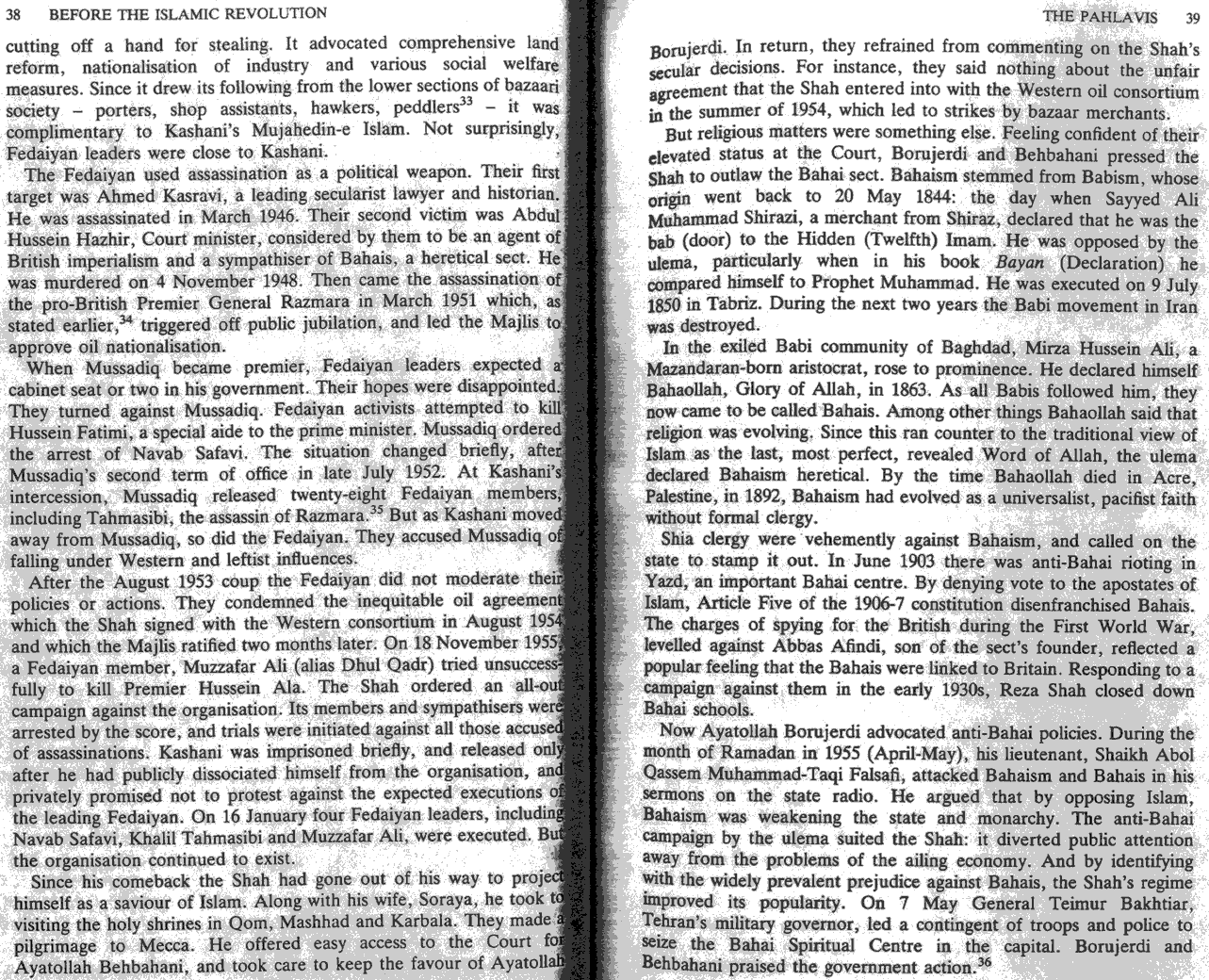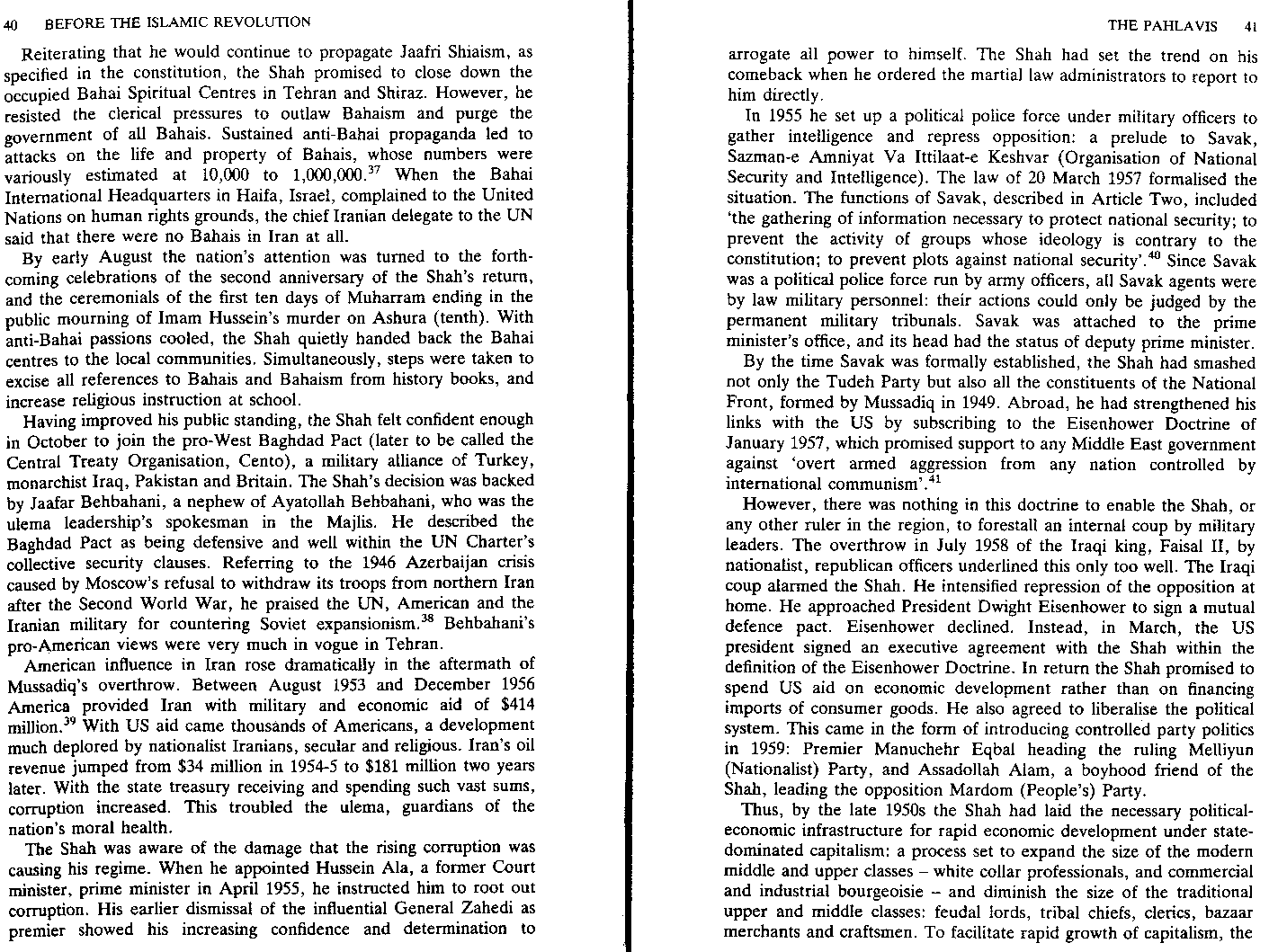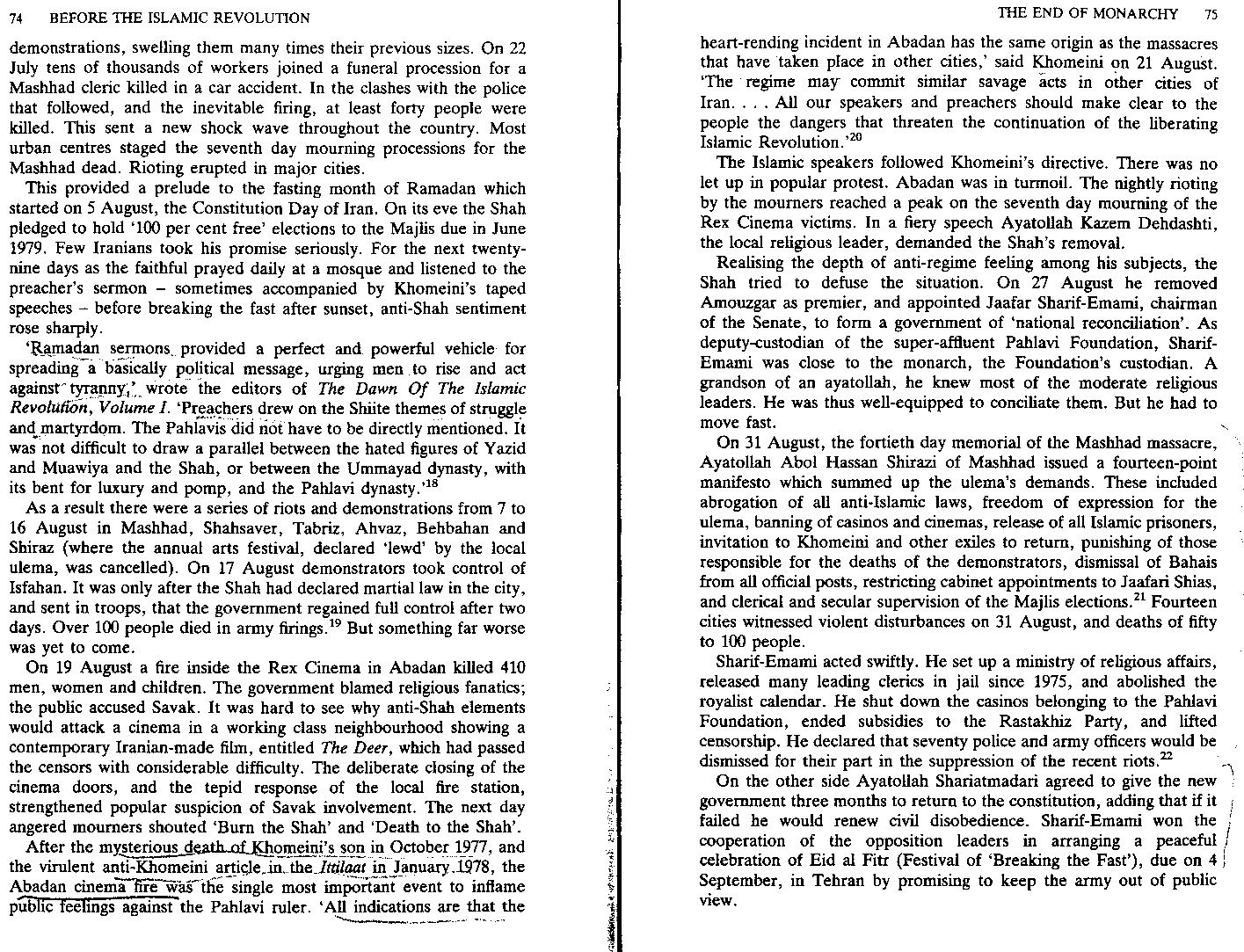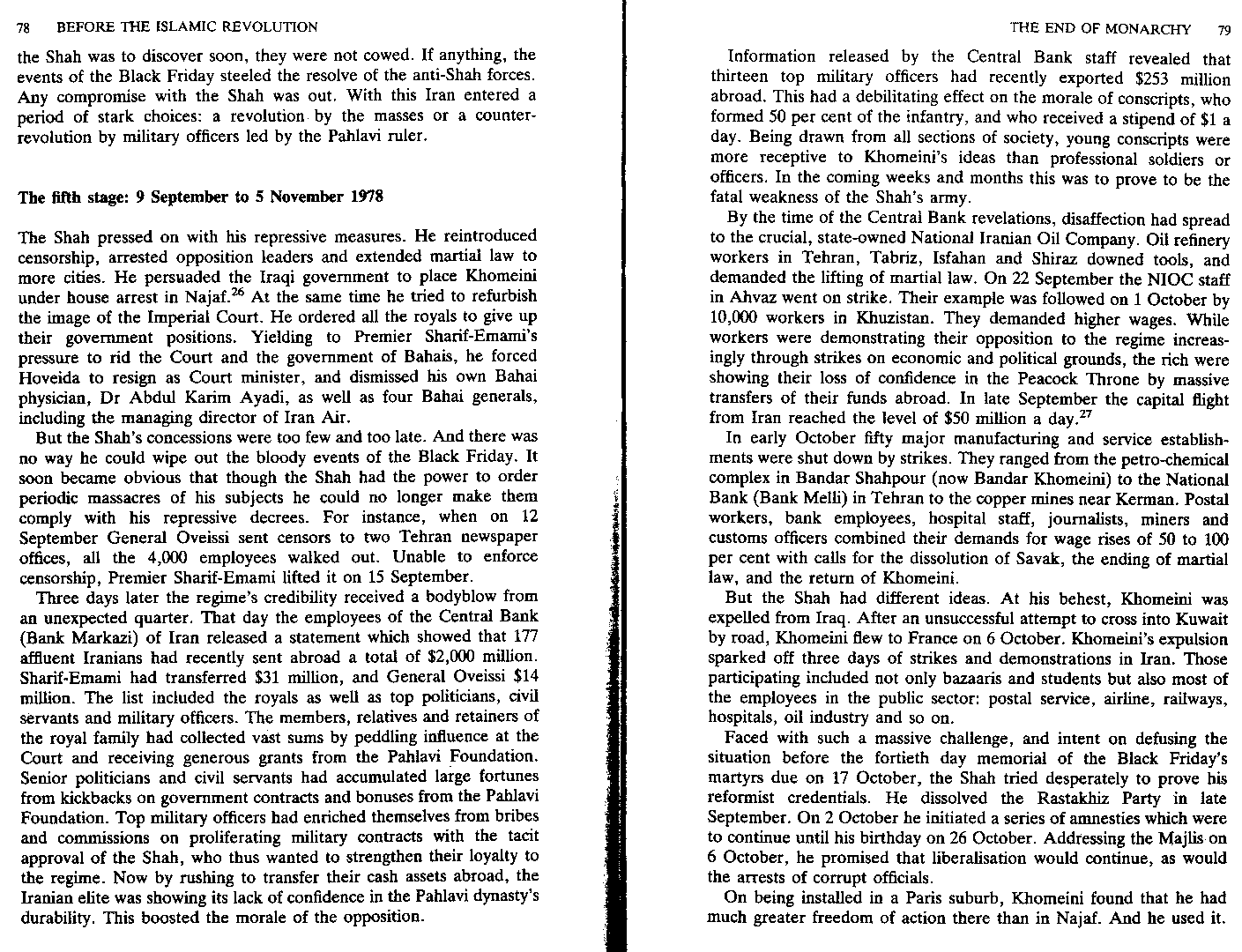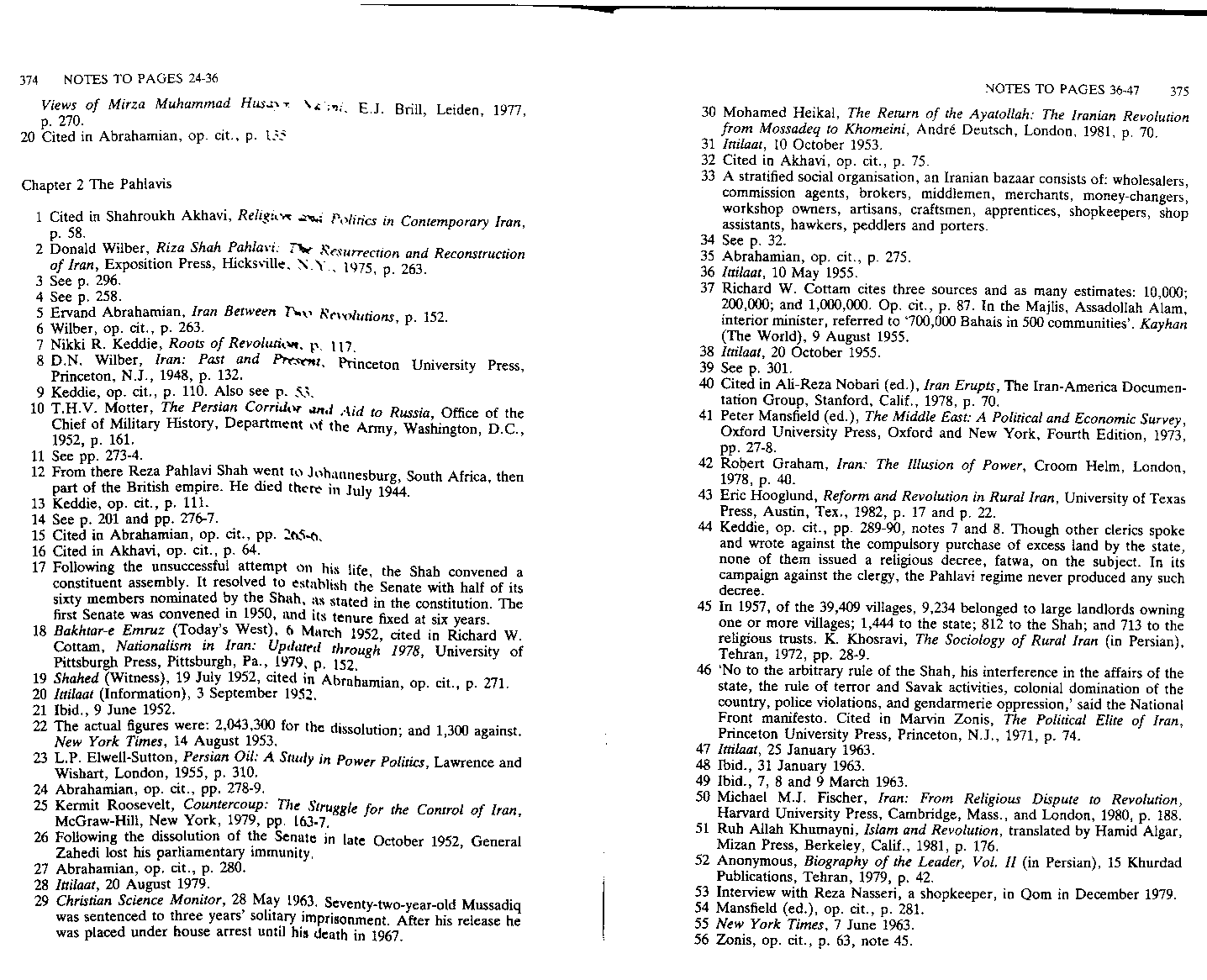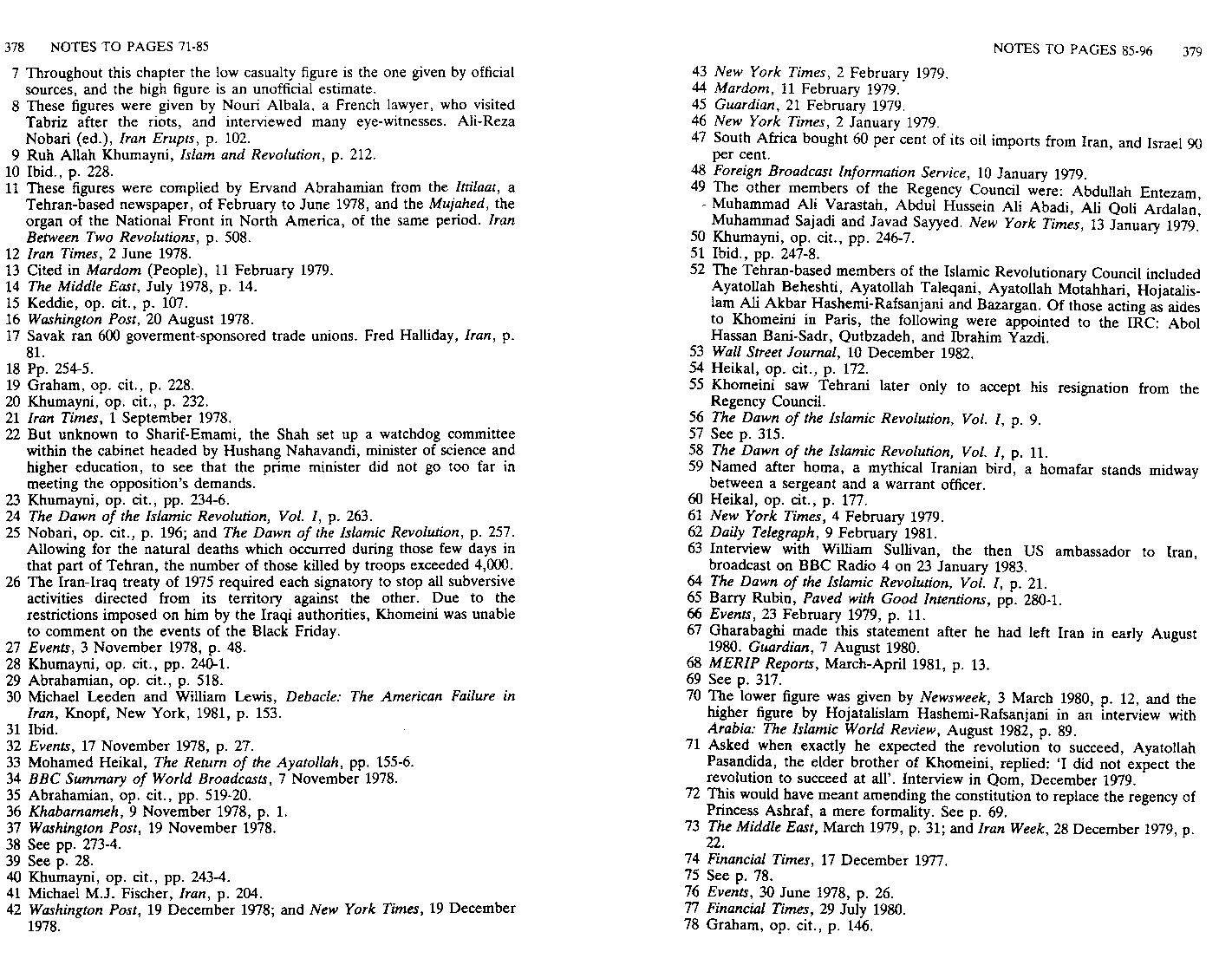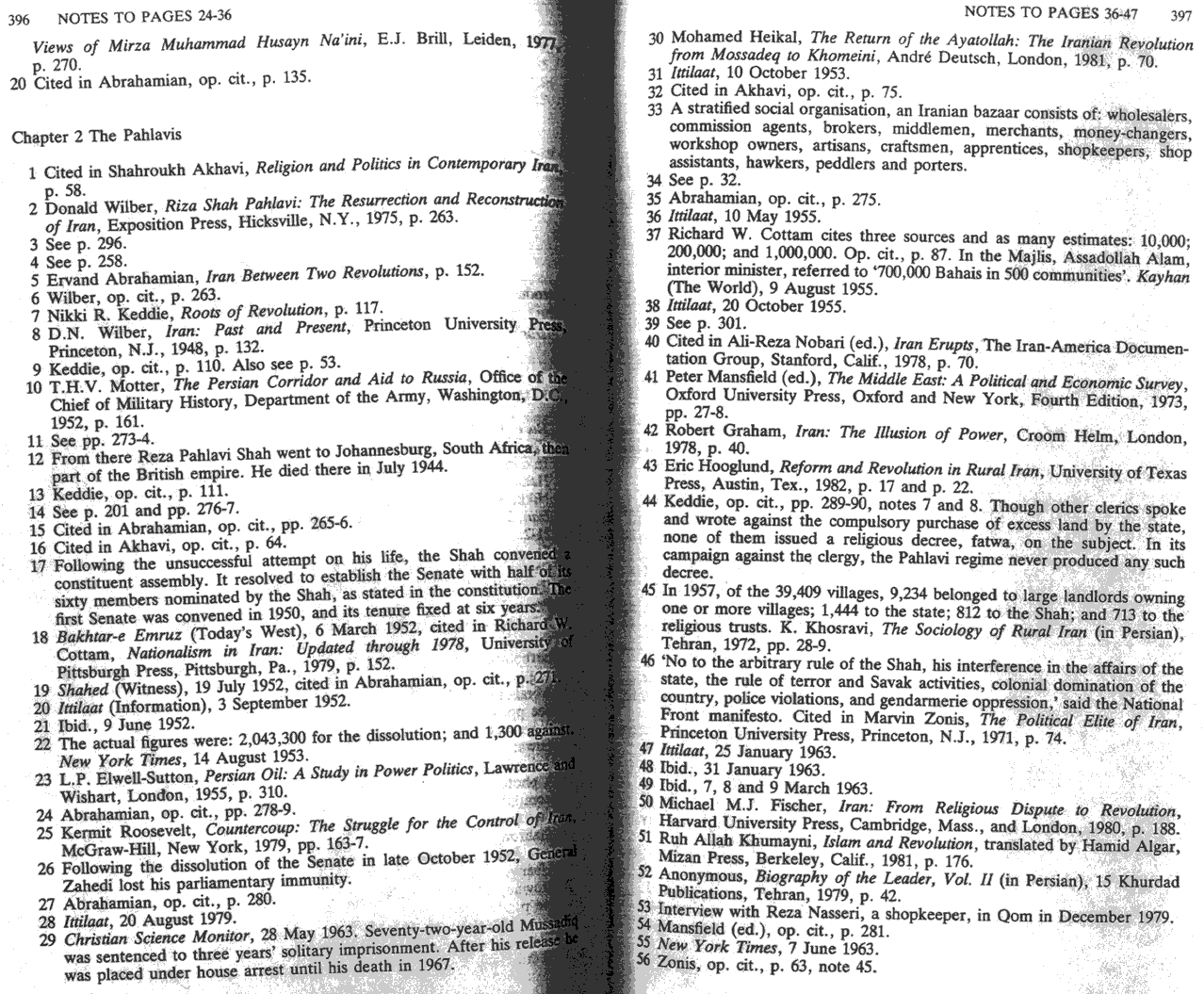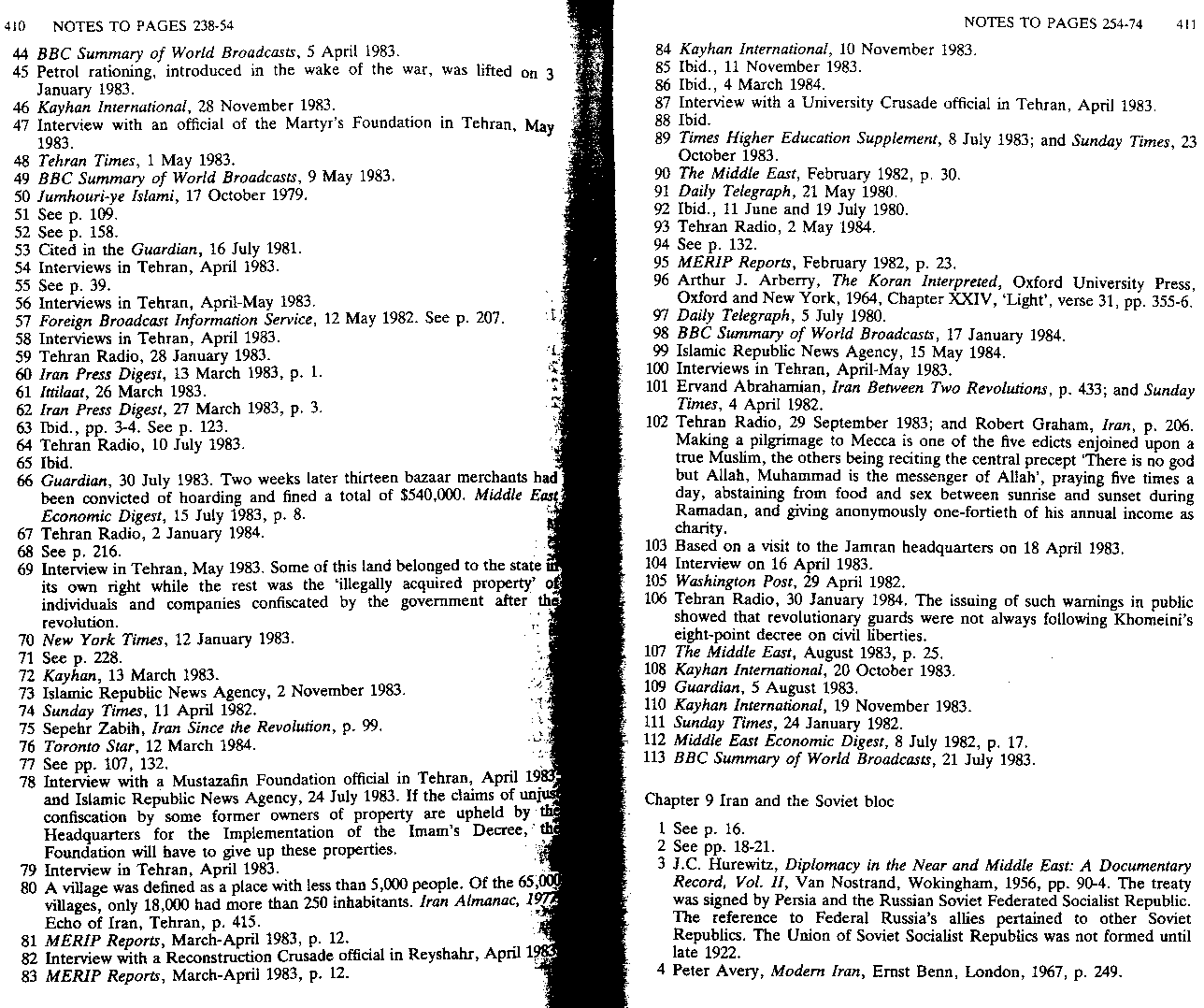
|
|
Abstract: Mentions of persecutions of Baha'is in 1903, 1955, and 1978. |
Iran under the Ayatollahs
by Dilip Hiro
pages 38-40, 75, 78, 243London: Routledge & Kegan Paul, 1985
1. Text
[page 38]... The Fedaiyan used assassination as a political weapon. Their first target was Ahmed Kasravi, leading secularist lawyer and historian. He was assassinated in March 1946. Their second victim was Abdul Hussein Hazhir, Court minister, considered by them to be an agent of British imperialism and a sympathiser of Bahais, a heretical sect.
[page 39]
... But religious matters were something else. Feeling confident of their elevated status at the Court, Borujerdi and Behbahani pressed the Shah to outlaw the Bahai sect. Bahaism stemmed from Babism, whose origin went back to 20 May 1844: the day when Sayyed Ali Muhammad Shirazi, a merchant from Shiraz, declared that he was the bab (door) to the Hidden (Twelfth) Imam He was opposed by the ulema, particularly when in his book Bayan (Declaration) he compared himself to Prophet Muhammad. He was executed on 9 July 1850 in Tabriz. During the next two years the Babi movement in Iran was destroyed.
In the exiled Babi community of Baghdad, Mirza Hussein Ali, a Mazandaran-born aristocrat, rose to prominence. He declared himself Bahaollah, Glory of Allah, in 1863. As all Babis followed him, they now came to be called Bahais. Among other things Bahaollah said that religion was evolving. Since this ran counter to the traditional view of Islam as the last, most perfect, revealed Word of Allah, the ulema declared Bahaism heretical. By the time Bahaollah died in Acre, Palestine, in 1892, Bahaism had evolved as a universalist, pacifist faith without formal clergy.
Shia clergy were vehemently against Bahaism, and called on the state to stamp it out. in June 1903 there was anti-Bahai rioting in Yazd, an important Bahai centre. By denying vote to the apostates of Islam, Article Five of the 1906-7 constitution disenfranchised Bahais. The charges of spying for the British during the First World War, levelled against Abbas Afindi, son of the sect’s founder, reflected a popular feeling that the Bahais were linked to Britain. Responding to a campaign against them in the early 1930s, Reza Shah closed down Bahai schools.
Now Ayatollah Borujerdi advocated anti-Bahai policies. During the month of Ramaḍán in 1955 (April-May), his lieutenant, Shaikh Abol Qassem Muhammad-Taqí Falsafi, attacked Bahaism and Bahais in his sermons on the state radio. He argued that by opposing Islam, Bahaism was weakening the state and monarchy. The anti-Bahai campaign by the ulema suited the Shah: it diverted pubic attention away from the problems of the ailing economy. And by identifying with the widely prevalent prejudice against Bahais, the Shah’s regime improved its popularity. On 7 May General Teimur Bakhtiar,
Tehran’s military governor, led a contingent of troops and police to seize the Bahai Spiritual Centre in the capital. Borujerdi and Behbahani praised the government action. [footnote: Ittilaat, 10 May 1955.]
[page 40]
... Reiterating that he would continue to propagate Jaafri Shiaism, as specified in the constitution, the Shah promised to close down the occupied Bahai Spiritual Centres in Tehran and Shiraz. However, he resisted the clerical pressures to outlaw Bahaism and purge the government of all Bahais. Sustained anti-Bahai propaganda led to attacks on the life and property of Bahais, whose numbers were variously estimated at 10,000 to 1,000,000. [footnote: Richard W. Cottam cites three sources and as many estimates: 10,000; 200,000; and 1,000,000. Op. cit., p. 87. In the Majlis, Assadollah Alam, interior minister, referred to ‘700,000 Bahais in 500 communities’. Kayhan (The World), 9 August 1955.] When the Bahai International Headquarters in Haifa, Israel, complained to the United Nations on human rights grounds, the chief Iranian delegate to the UN said there were no Bahais in Írán at all.
By early August the nation’s attention was turned to the forth-coming celebrations of the second anniversary of the Shah’s return, and the ceremonials of the first ten days of Muharram ending in the public mourning of Imam Hussein’s murder on Ashura (tenth). With anti-Bahai passions cooled, the Shah quietly handed back the Bahai centres to the local communities. Simultaneously, steps were taken to excise all references to Bahais and Bahaism from history books, and increase religious instruction at school.
[page 75]
... On 31 August, the fortieth day memorial of the Mashhad massacre, Ayatollah Abol Hassan Shirazi of Mashhad issued a fourteen-point manifesto which summed up the ulema’s demands. These included abrogation of all anti-Islamic laws, freedom of expression for the ulema, banning of casinos and cinemas, release of all Islamic prisoners, invitation to Khomeini and other exiles to return, punishing of those responsible fro the deaths of the demonstrators, dismissal of Bahais from all official posts, restricting cabinet appointments to Jaafari Shias, and clerical and secular supervision of the Majlis elections. [footnote: Iran Times, 1 September 1978.]
[page 78]
... The Shah pressed on with his repressive measures. He reintroduced censorship, arrested opposition leaders and extended martial law to more cities. He persuaded the Iraqi government to place Khomeini under house arrest in Najaf. [footnote: The Iran-Iraq treaty of 1975 required each signatory to stop all subversive activities directed from its territory against the other. Due to the restrictions imposed on him by the Iraqi authorities, Khomeini was unable to comment on the events of the Black Friday.] The same time he tried to refurbish the image of the Imperial Court. He ordered all the royals to give up their government positions. Yielding to Premier Sharif-Emani’s pressure to rid the Court and the government of Bahais, he forced Hoveida to resign as Court minister, and dismissed his own Bahai physician, Dr Abdul Karim Ayadi, as well as four Bahai generals, including the managing director of Iran Air.
[page 243]
... Despite the revolution, one Islamic organisation still remains secret: the Hojatiyeh. Formed in the early 1930s, it was inspired by the writings of Mirza Mahdi Isfahani, who argued that the Twelfth Imam was infallible and that his authority could not be encroached upon by any Muslim, who could at most be considered his deputy. As Islamic purists, Hojatiyeh members advocated complete purification of Iranian Muslim society, starting with the elimination of (heretic) Bahais and (Godless) communists. They considered Bahais heretic, because their leader claimed to be a prophet of Allah, something contrary to a basic Muslim belief that Muhammad was the last prophet. [footnote: See p. 39.] They secretly collected the names of Bahais in their neighbourhoods, and actively participated in the 1955-6 anti-Bahai riots.
2. Image scans (click image for full-size version)
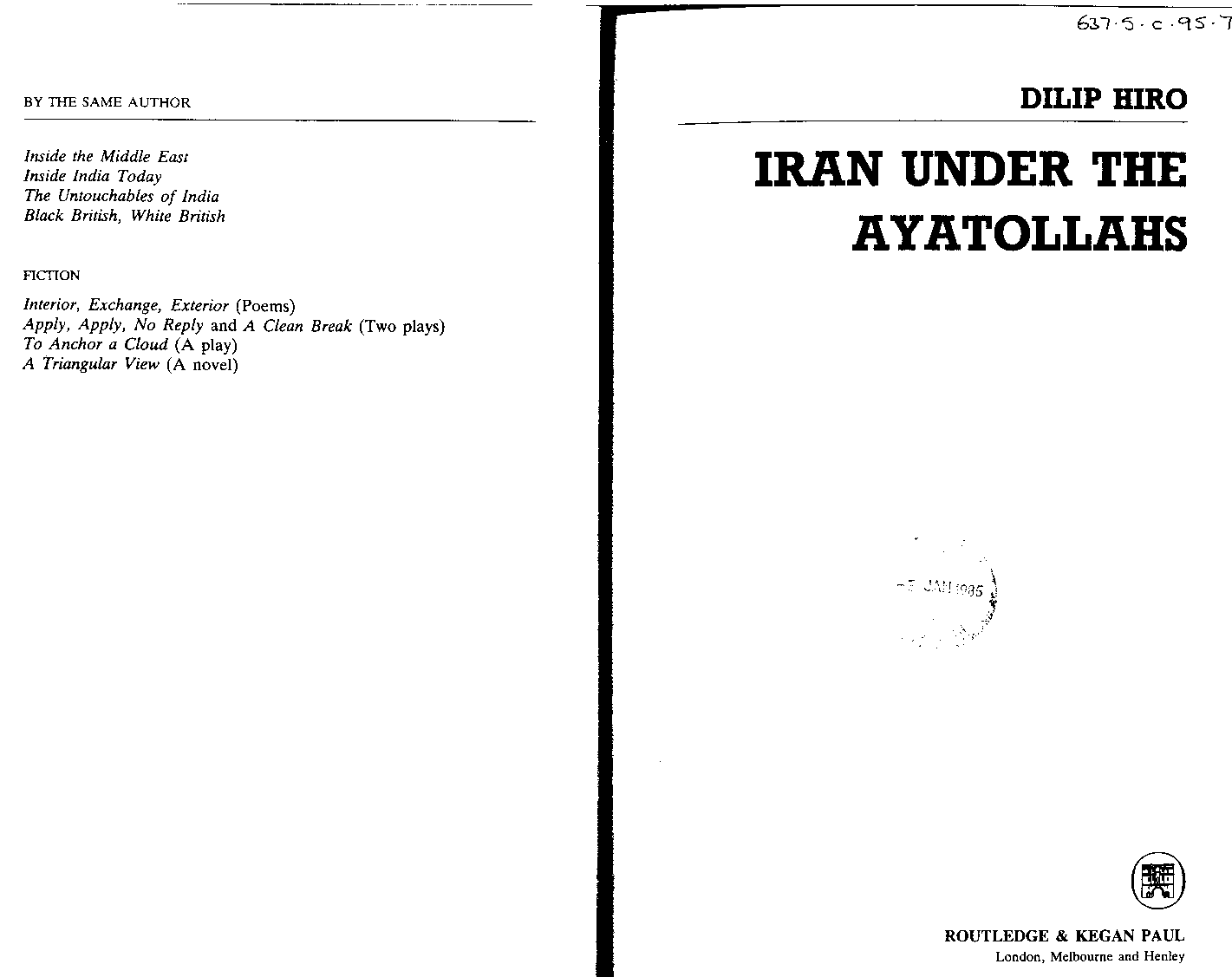
|
|
